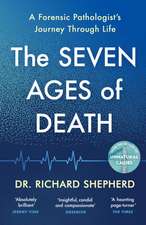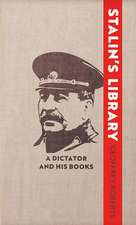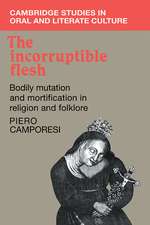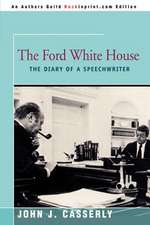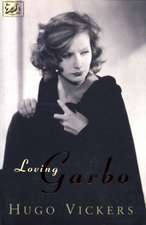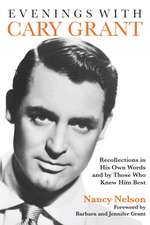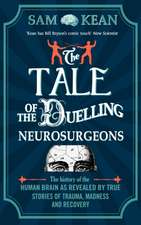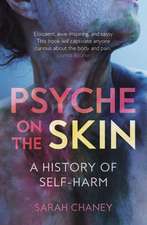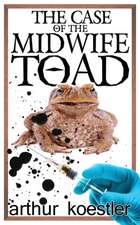The Knife Man
Autor Wendy Mooreen Limba Engleză Paperback – 3 apr 2006
| Toate formatele și edițiile | Preț | Express |
|---|---|---|
| Paperback (2) | 72.50 lei 24-30 zile | +30.50 lei 5-11 zile |
| Transworld Publishers Ltd – 3 apr 2006 | 72.50 lei 24-30 zile | +30.50 lei 5-11 zile |
| BROADWAY BOOKS – 31 aug 2006 | 111.58 lei 3-5 săpt. |
Preț: 72.50 lei
Preț vechi: 84.44 lei
-14% Nou
Puncte Express: 109
Preț estimativ în valută:
13.87€ • 14.43$ • 11.45£
13.87€ • 14.43$ • 11.45£
Carte disponibilă
Livrare economică 27 martie-02 aprilie
Livrare express 08-14 martie pentru 40.49 lei
Preluare comenzi: 021 569.72.76
Specificații
ISBN-13: 9780553816181
ISBN-10: 0553816187
Pagini: 656
Ilustrații: Illustrations
Dimensiuni: 128 x 199 x 50 mm
Greutate: 0.45 kg
Editura: Transworld Publishers Ltd
Locul publicării:United Kingdom
ISBN-10: 0553816187
Pagini: 656
Ilustrații: Illustrations
Dimensiuni: 128 x 199 x 50 mm
Greutate: 0.45 kg
Editura: Transworld Publishers Ltd
Locul publicării:United Kingdom
Notă biografică
Wendy Moore is a writer and journalist. After working as a reporter for local newspapers she has specialized in health and medical topics for more than twenty years. As a freelance journalist her work has been published in a range of newspapers and magazines, including the Guardian, the Observer and the British Medical Journal, and has won several awards. Having written extensively on medical history, she obtained the Diploma in the History of Medicine from the Society of Apothecaries (DHMSA) in 1999 and won the Maccabean prize for best dissertation that year. She lives in south London with her partner, Peter, also a journalist, and two children, Sam and Susannah. The Knife Man is her first book.
Extras
CHAPTER 1
The Coach Driver’s Knee
St. George’s Hospital, Hyde Park Corner, London December 1785
The patient faced an agonizing choice. Above the cries and moans of fellow sufferers on the fetid ward, he listened as the surgeon outlined the dilemma. If the large swelling at the back of his knee was left to continue growing, it would soon burst, leading to certain and painful death. If, on the other hand, the leg was amputated above the knee, there was a slim chance he would survive the crude operation–provided he did not die of shock on the operating table, or bleed to death soon after, or succumb to infection on the filthy ward days later–but he would be permanently disabled.
For the forty-five-year-old hackney coach driver, both options were unthinkable. Since he had first noticed the swelling in the hollow behind his knee three years ago, the lump had grown steadily, until it was the size of an orange.(1) It throbbed continuously and was now so painful, he could barely walk. Extended on the hospital bed before him, his leg and foot were hideously swollen, while his skin had turned an unsightly mottled brown. Once the coachman had gained admittance to St. George’s, having persuaded the governors he was a deserving recipient of their charity, the surgeon on duty had lost no time in making a diagnosis. He had seen popliteal aneurysms at exactly the same spot on numerous occasions and knew the prognosis all too well.
It was a common-enough problem in the cabdriver’s line of work. Aneurysms could happen to anyone, anywhere in the body, but they appeared to occur with particular frequency among coach drivers, and others in equestrian occupations in Georgian London, in the popliteal artery behind the knee. The condition, in which a section of artery that has been injured or otherwise weakened begins to bulge to form a blood-filled sac, may well have been triggered by the wearing of high leather riding boots, which rubbed the back of the knee.(2) As the aneurysm swelled, it not only became extremely painful but made walking exceedingly difficult. Whatever the cause, the outcome was often an early death–if not from the condition itself, then from the treatment generally meted out. To lose his leg, even supposing the coach driver survived such a drastic procedure in an era long before anesthesia or antiseptics, would mean never being able to work again. But to carry on working, navigating his horse-drawn carriage over London’s rutted and congested roads, would be equally impossible if the lump was left to grow. Either way, the cabbie feared destitution and the workhouse.
But there was a third choice, the surgeon at his bedside now confided on that early December day, for a coachman sufficiently willing or desperate. In his slow Scottish lilt, redolent of his humble farming origins, the surgeon laid out his scheme for a daring new operation. Surrounded by the poxed, maimed, and diseased bodies of London’s poorest wretches, huddled in their beds on the drafty ward, the cabbie resolved to put his life in the hands of John Hunter.
Without a doubt, John Hunter’s reputation was well known to the coach driver long before he limped through the portal of St. George’s, for he was generally acknowledged as one of the best-skilled surgeons in London, if not Europe, and was a favorite among the well-heeled and the unshod alike. As well as working for no recompense patching up the poor in St. George’s, he was in constant demand from the fee-paying patients who thronged each morning to his fashionable home in Leicester Square or called him out for consultations in the elegant drawing rooms of their West End villas. For all his blunt manners, coarse speech, and disdain for fashion–he currently sported an unkempt beard and tied his tawny-colored hair behind his head in preference to wearing the customary wig– Hunter was firmly established in Georgian high society. He visited court as surgeon extraordinary to George III, dined with the society artist Sir Joshua Reynolds, and debated science with his close friend, the well-connected naturalist Sir Joseph Banks.
Now aged fifty-seven, with seventeen years’ service at St. George’s under his belt, Hunter was renowned for his pioneering and controversial operations. Only two months before the coach driver’s admission, he had skillfully cut away from the neck of a thirty-seven-year-old man a massive benign tumor weighing more than eight pounds and roughly the size of an extra head. The relieved patient had walked away with only a long, neat scar as souvenir of his ordeal.(3) Hunter was popular with the medical students, too. The coachman had watched the eager pupils trooping devotedly after their teacher on his ward rounds, for more students flocked to Hunter’s side than to all the other surgeons at St. George’s put together.(4) Aspiring young surgeons traveled not only from the far reaches of the British Isles but even from across the Atlantic to “walk the wards” at Hunter’s side and hear their hero expound on his radical views in the private lectures he held at his home each winter.
But the cabbie would have heard darker stories, too, whispered on the wards, insinuated in newspapers, and muttered in coffeehouses and cockpits, for Hunter was as much feared and despised as admired in eighteenth-century London. Although his pupils idolized their master, and patients often had cause to thank the bluff but honest surgeon, Hunter’s fiery temper and maverick views had earned him powerful enemies within the four walls of St. George’s, and beyond. While aristocrats bowed to his medical advice, and denizens of the Royal Society–the engine room of eighteenth-century progress–hung on his every pronouncement, Hunter was isolated at St. George’s. To his fellow surgeons, he was at best a laughingstock and at worst a reckless fool. And he had quarreled, too, with several of the city’s other leading practitioners, not least his own elder brother.
To the students, the explanation for this was straightforward: Hunter was simply so far ahead of his contemporaries that he stood alone. But his rivals at St. George’s had other opinions. They decried Hunter’s novel approach and controversial methods, preferring to bleed, blister, and purge their patients to early graves–in strict accordance with classical teaching–than to question conventional modes of practice. They even encouraged Hunter’s most vociferous enemy, a mediocre house surgeon named Jessé Foot, who worked in a neighboring hospital, and whom Hunter had upset by criticizing a surgical appliance the young upstart had invented. In Foot’s jaundiced view, Hunter was “a very inferior, dangerous, and irregular practical surgeon” who was embroiled in “continual war” at St. George’s.(5)
But there were stranger stories still about the rebellious surgeon.
Hunter was known to keep rare and exotic wild beasts–including a lion, a jackal, a dingo, and two leopards–at his country home in the tranquil village of Earls Court, a few miles west of London. In this rural retreat, the surgeon performed countless experiments on animals both dead and alive. Innumerable research papers, presented to his friends in the Royal Society, detailed his bizarre trials, such as grafting a cockerel’s testicle into the belly of a hen–an early step toward transplanting body parts in humans–as well as the freezing of fish and rabbits’ ears in a forlorn attempt to invent a scheme for human immortality. At this prototype research center, Hunter dissected great carcasses, including whales washed up on the banks of the Thames, apes sent back from explorations into unmapped territories, and elephants donated by Queen Charlotte. It was here, too, that he experimented on living animals, tying down squealing pigs, sheep, and dogs for lengthy dissections in order to explore how healthy organs function and to test ways to improve surgery. Although by now they had become inured to the sight of rare beasts grazing the lawns, Hunter’s curious neighbors still gaped on occasions when the surgeon set out from Earls Court driving a cart pulled by three Asian buffalo, headed for the West End. Arriving at his Leicester Square town house, a drawbridge could be swiftly lowered– and just as swiftly raised–to allow mysterious cargoes to trundle in and out.(6)
The enterprising surgeon did not confine his zeal for research to the animal kingdom, however, for Hunter had built up his surgical expertise through an unrivaled knowledge of human anatomy. Since arriving in London almost four decades earlier, Hunter had dissected human bodies in unprecedented numbers. By his own admission, he had carved up “some thousands” during his lengthy career.(7) It was through this relentless firsthand exploration of the human body, rather than by reading the works of the ancient Greeks and Romans or passively watching over the shoulders of other practitioners, that Hunter had become such a skilled operator. Although other surgeons of the day had become adept at certain procedures through trial and error, many operations performed in London’s charity hospitals were still risky gambles, due to ignorance of anatomy and physiology. Whenever Hunter cut, probed, sliced, and sawed, he knew precisely what lay beneath. He possessed a better knowledge than any other surgeon in town of the exact whereabouts, functions, and habits of every organ, muscle, blood vessel, and tissue, healthy or diseased, that he was likely to encounter.
Yet while many of Hunter’s patients, rich and poor, were grateful for their surgeon’s intimate knowledge of the human body, few gave their approval to the sinister extremes to which he went to obtain his research material. Like most surgeons and anatomists of the time, Hunter had no lawful source for the majority of the bodies he daily dissected. Like others, he was forced to adopt underhanded means to pursue his work, turning to London’s criminal elements to supply his needs. Hunter, however, went further than any other anatomist of the day in his connections with the Georgian underworld. Desperate to expand his collection of animal and human specimens in the remarkable museum he had just established at his Leicester Square house, Hunter was notorious for paying above the norm for any kind of anatomical curiosity–whether rare human deformities or the results of a pioneering, but ultimately fatal, operation.
So as the tortured coach driver stared anxiously from his hospital bed into Hunter’s pale blue eyes, he knew that volunteering to go under the renowned surgeon’s knife in the operating theater at St. George’s could very well mean going under his knife a second time–dead on the dissection table, with his mutilated leg destined for the anatomist’s museum. Nonetheless, clinging to the slim prospect of recovery held out to him, he gave John Hunter his consent for the new operation.
For Hunter, the coach driver represented the perfect human guinea pig. Until now, he had tried to save patients with popliteal aneurysms from either a premature death or a life-threatening amputation by performing an operation that he knew was highly risky and exceedingly painful. This procedure, which had been attempted by surgeons across Europe with various refinements for some centuries, meant cutting straight into the back of the knee, tying the damaged artery above and below the aneurysm, and scraping out the blood-filled sac. Based on his knowledge of anatomy and research, Hunter believed that once prevented from taking its usual path down the popliteal artery, the blood supply would find alternative routes– or “collateral circulation”–through the smaller blood vessels in the area. Almost without exception, the technique had failed. More often than not, the already-weakened blood vessel burst and the patient bled to death, making Hunter the butt of his colleagues’ scorn.
Given such outcomes, Percivall Pott, a respected surgeon at St. Bartholomew’s Hospital, as well as Hunter’s former teacher, insisted that amputation was the only viable remedy for popliteal aneurysms–even though he admitted the procedure was “terrible to bear” and “horrid to see.”(8) The surrounding blood vessels in the leg were simply too few and too small, Pott argued, to foster collateral circulation once the main artery was tied. Conversely, William Bromfield, the recently retired senior surgeon at St. George’s, who had once been Hunter’s examiner for his surgeon’s diploma, proclaimed that neither amputation nor “Hunter’s operation” were of the slightest use in treating the condition. Mistakenly averring that a popliteal aneurysm indicated that a patient’s entire arterial system was diseased, he insisted that there was simply no cure for the problem.9 It was an opinion that effectively dealt a death sentence to every poor coachman who ventured into Bromfield’s care.
Never one to bow to authority or defer to his elders, Hunter was not prepared simply to abandon hope and consign his patients to a lingering, agonizing death. His aversion to drastic surgery except as a last resort, and his firm belief in nature’s healing powers, made him equally unwilling to perform amputations. Refusing to be defeated, he resolved to apply his singular approach to the problem. Unlike the vast majority of surgeons operating in London homes and hospitals, who wielded their lancets and saws in imitation of long-dead past masters while rarely considering any need for improvement, Hunter believed all surgery should be governed by scientific principles, which were based on reasoning, observation, and experimentation.
Techniques for most operations had changed little since medieval times, while treatment regimes still owed their basic principles largely to the theories of the ancient Greeks. Although medical students usually learned some rudimentary anatomy, this was considered a useful but not vital adjunct to on-the-job experience. And when patients died on the operating table as a result of ignorance and blundering, as they frequently did, few, if any, lessons were learned from the outcome.
Hunter, however, had enjoyed a distinctly different preparation for the job, having spent a full twelve years studying anatomy in his brother William’s dissecting rooms and only a brief spell walking the wards, before embarking on his surgical career. As a consequence, he considered anatomy the foundation stone for all surgery. He believed that only by minutely studying the human body, in order to understand the whereabouts and functions of every living part, could surgeons possibly hope to improve their skills. Furthermore, his experience on the hospital wards had taught him principally, in ghastly and bloody detail, how primitive his profession really was.
So Hunter had set out systematically to question every established practice, develop hypotheses to advance better methods, and test by means of rigorous observation, investigation, and experiment whether these methods worked. Often he tried out his theories on animals before attempting new procedures on humans, while the results of the handiwork he performed in the operating theater were always carefully observed during the patient’s subsequent recovery, or, if the person died, in autopsy investigations. The lessons he learned were diligently applied to modify his methods, resulting in a continuous research loop, which would still stand up to scientific scrutiny more than two centuries later. Instilling the same approach in his pupils, Hunter summed up his doctrine in characteristically concise style when his favorite protégé, Edward Jenner–who would later develop the smallpox vaccine–asked him for help in solving a problem. “I think your solution is just,” responded his mentor, “but why think, why not trie the Expt.”(10)
From the Hardcover edition.
The Coach Driver’s Knee
St. George’s Hospital, Hyde Park Corner, London December 1785
The patient faced an agonizing choice. Above the cries and moans of fellow sufferers on the fetid ward, he listened as the surgeon outlined the dilemma. If the large swelling at the back of his knee was left to continue growing, it would soon burst, leading to certain and painful death. If, on the other hand, the leg was amputated above the knee, there was a slim chance he would survive the crude operation–provided he did not die of shock on the operating table, or bleed to death soon after, or succumb to infection on the filthy ward days later–but he would be permanently disabled.
For the forty-five-year-old hackney coach driver, both options were unthinkable. Since he had first noticed the swelling in the hollow behind his knee three years ago, the lump had grown steadily, until it was the size of an orange.(1) It throbbed continuously and was now so painful, he could barely walk. Extended on the hospital bed before him, his leg and foot were hideously swollen, while his skin had turned an unsightly mottled brown. Once the coachman had gained admittance to St. George’s, having persuaded the governors he was a deserving recipient of their charity, the surgeon on duty had lost no time in making a diagnosis. He had seen popliteal aneurysms at exactly the same spot on numerous occasions and knew the prognosis all too well.
It was a common-enough problem in the cabdriver’s line of work. Aneurysms could happen to anyone, anywhere in the body, but they appeared to occur with particular frequency among coach drivers, and others in equestrian occupations in Georgian London, in the popliteal artery behind the knee. The condition, in which a section of artery that has been injured or otherwise weakened begins to bulge to form a blood-filled sac, may well have been triggered by the wearing of high leather riding boots, which rubbed the back of the knee.(2) As the aneurysm swelled, it not only became extremely painful but made walking exceedingly difficult. Whatever the cause, the outcome was often an early death–if not from the condition itself, then from the treatment generally meted out. To lose his leg, even supposing the coach driver survived such a drastic procedure in an era long before anesthesia or antiseptics, would mean never being able to work again. But to carry on working, navigating his horse-drawn carriage over London’s rutted and congested roads, would be equally impossible if the lump was left to grow. Either way, the cabbie feared destitution and the workhouse.
But there was a third choice, the surgeon at his bedside now confided on that early December day, for a coachman sufficiently willing or desperate. In his slow Scottish lilt, redolent of his humble farming origins, the surgeon laid out his scheme for a daring new operation. Surrounded by the poxed, maimed, and diseased bodies of London’s poorest wretches, huddled in their beds on the drafty ward, the cabbie resolved to put his life in the hands of John Hunter.
Without a doubt, John Hunter’s reputation was well known to the coach driver long before he limped through the portal of St. George’s, for he was generally acknowledged as one of the best-skilled surgeons in London, if not Europe, and was a favorite among the well-heeled and the unshod alike. As well as working for no recompense patching up the poor in St. George’s, he was in constant demand from the fee-paying patients who thronged each morning to his fashionable home in Leicester Square or called him out for consultations in the elegant drawing rooms of their West End villas. For all his blunt manners, coarse speech, and disdain for fashion–he currently sported an unkempt beard and tied his tawny-colored hair behind his head in preference to wearing the customary wig– Hunter was firmly established in Georgian high society. He visited court as surgeon extraordinary to George III, dined with the society artist Sir Joshua Reynolds, and debated science with his close friend, the well-connected naturalist Sir Joseph Banks.
Now aged fifty-seven, with seventeen years’ service at St. George’s under his belt, Hunter was renowned for his pioneering and controversial operations. Only two months before the coach driver’s admission, he had skillfully cut away from the neck of a thirty-seven-year-old man a massive benign tumor weighing more than eight pounds and roughly the size of an extra head. The relieved patient had walked away with only a long, neat scar as souvenir of his ordeal.(3) Hunter was popular with the medical students, too. The coachman had watched the eager pupils trooping devotedly after their teacher on his ward rounds, for more students flocked to Hunter’s side than to all the other surgeons at St. George’s put together.(4) Aspiring young surgeons traveled not only from the far reaches of the British Isles but even from across the Atlantic to “walk the wards” at Hunter’s side and hear their hero expound on his radical views in the private lectures he held at his home each winter.
But the cabbie would have heard darker stories, too, whispered on the wards, insinuated in newspapers, and muttered in coffeehouses and cockpits, for Hunter was as much feared and despised as admired in eighteenth-century London. Although his pupils idolized their master, and patients often had cause to thank the bluff but honest surgeon, Hunter’s fiery temper and maverick views had earned him powerful enemies within the four walls of St. George’s, and beyond. While aristocrats bowed to his medical advice, and denizens of the Royal Society–the engine room of eighteenth-century progress–hung on his every pronouncement, Hunter was isolated at St. George’s. To his fellow surgeons, he was at best a laughingstock and at worst a reckless fool. And he had quarreled, too, with several of the city’s other leading practitioners, not least his own elder brother.
To the students, the explanation for this was straightforward: Hunter was simply so far ahead of his contemporaries that he stood alone. But his rivals at St. George’s had other opinions. They decried Hunter’s novel approach and controversial methods, preferring to bleed, blister, and purge their patients to early graves–in strict accordance with classical teaching–than to question conventional modes of practice. They even encouraged Hunter’s most vociferous enemy, a mediocre house surgeon named Jessé Foot, who worked in a neighboring hospital, and whom Hunter had upset by criticizing a surgical appliance the young upstart had invented. In Foot’s jaundiced view, Hunter was “a very inferior, dangerous, and irregular practical surgeon” who was embroiled in “continual war” at St. George’s.(5)
But there were stranger stories still about the rebellious surgeon.
Hunter was known to keep rare and exotic wild beasts–including a lion, a jackal, a dingo, and two leopards–at his country home in the tranquil village of Earls Court, a few miles west of London. In this rural retreat, the surgeon performed countless experiments on animals both dead and alive. Innumerable research papers, presented to his friends in the Royal Society, detailed his bizarre trials, such as grafting a cockerel’s testicle into the belly of a hen–an early step toward transplanting body parts in humans–as well as the freezing of fish and rabbits’ ears in a forlorn attempt to invent a scheme for human immortality. At this prototype research center, Hunter dissected great carcasses, including whales washed up on the banks of the Thames, apes sent back from explorations into unmapped territories, and elephants donated by Queen Charlotte. It was here, too, that he experimented on living animals, tying down squealing pigs, sheep, and dogs for lengthy dissections in order to explore how healthy organs function and to test ways to improve surgery. Although by now they had become inured to the sight of rare beasts grazing the lawns, Hunter’s curious neighbors still gaped on occasions when the surgeon set out from Earls Court driving a cart pulled by three Asian buffalo, headed for the West End. Arriving at his Leicester Square town house, a drawbridge could be swiftly lowered– and just as swiftly raised–to allow mysterious cargoes to trundle in and out.(6)
The enterprising surgeon did not confine his zeal for research to the animal kingdom, however, for Hunter had built up his surgical expertise through an unrivaled knowledge of human anatomy. Since arriving in London almost four decades earlier, Hunter had dissected human bodies in unprecedented numbers. By his own admission, he had carved up “some thousands” during his lengthy career.(7) It was through this relentless firsthand exploration of the human body, rather than by reading the works of the ancient Greeks and Romans or passively watching over the shoulders of other practitioners, that Hunter had become such a skilled operator. Although other surgeons of the day had become adept at certain procedures through trial and error, many operations performed in London’s charity hospitals were still risky gambles, due to ignorance of anatomy and physiology. Whenever Hunter cut, probed, sliced, and sawed, he knew precisely what lay beneath. He possessed a better knowledge than any other surgeon in town of the exact whereabouts, functions, and habits of every organ, muscle, blood vessel, and tissue, healthy or diseased, that he was likely to encounter.
Yet while many of Hunter’s patients, rich and poor, were grateful for their surgeon’s intimate knowledge of the human body, few gave their approval to the sinister extremes to which he went to obtain his research material. Like most surgeons and anatomists of the time, Hunter had no lawful source for the majority of the bodies he daily dissected. Like others, he was forced to adopt underhanded means to pursue his work, turning to London’s criminal elements to supply his needs. Hunter, however, went further than any other anatomist of the day in his connections with the Georgian underworld. Desperate to expand his collection of animal and human specimens in the remarkable museum he had just established at his Leicester Square house, Hunter was notorious for paying above the norm for any kind of anatomical curiosity–whether rare human deformities or the results of a pioneering, but ultimately fatal, operation.
So as the tortured coach driver stared anxiously from his hospital bed into Hunter’s pale blue eyes, he knew that volunteering to go under the renowned surgeon’s knife in the operating theater at St. George’s could very well mean going under his knife a second time–dead on the dissection table, with his mutilated leg destined for the anatomist’s museum. Nonetheless, clinging to the slim prospect of recovery held out to him, he gave John Hunter his consent for the new operation.
For Hunter, the coach driver represented the perfect human guinea pig. Until now, he had tried to save patients with popliteal aneurysms from either a premature death or a life-threatening amputation by performing an operation that he knew was highly risky and exceedingly painful. This procedure, which had been attempted by surgeons across Europe with various refinements for some centuries, meant cutting straight into the back of the knee, tying the damaged artery above and below the aneurysm, and scraping out the blood-filled sac. Based on his knowledge of anatomy and research, Hunter believed that once prevented from taking its usual path down the popliteal artery, the blood supply would find alternative routes– or “collateral circulation”–through the smaller blood vessels in the area. Almost without exception, the technique had failed. More often than not, the already-weakened blood vessel burst and the patient bled to death, making Hunter the butt of his colleagues’ scorn.
Given such outcomes, Percivall Pott, a respected surgeon at St. Bartholomew’s Hospital, as well as Hunter’s former teacher, insisted that amputation was the only viable remedy for popliteal aneurysms–even though he admitted the procedure was “terrible to bear” and “horrid to see.”(8) The surrounding blood vessels in the leg were simply too few and too small, Pott argued, to foster collateral circulation once the main artery was tied. Conversely, William Bromfield, the recently retired senior surgeon at St. George’s, who had once been Hunter’s examiner for his surgeon’s diploma, proclaimed that neither amputation nor “Hunter’s operation” were of the slightest use in treating the condition. Mistakenly averring that a popliteal aneurysm indicated that a patient’s entire arterial system was diseased, he insisted that there was simply no cure for the problem.9 It was an opinion that effectively dealt a death sentence to every poor coachman who ventured into Bromfield’s care.
Never one to bow to authority or defer to his elders, Hunter was not prepared simply to abandon hope and consign his patients to a lingering, agonizing death. His aversion to drastic surgery except as a last resort, and his firm belief in nature’s healing powers, made him equally unwilling to perform amputations. Refusing to be defeated, he resolved to apply his singular approach to the problem. Unlike the vast majority of surgeons operating in London homes and hospitals, who wielded their lancets and saws in imitation of long-dead past masters while rarely considering any need for improvement, Hunter believed all surgery should be governed by scientific principles, which were based on reasoning, observation, and experimentation.
Techniques for most operations had changed little since medieval times, while treatment regimes still owed their basic principles largely to the theories of the ancient Greeks. Although medical students usually learned some rudimentary anatomy, this was considered a useful but not vital adjunct to on-the-job experience. And when patients died on the operating table as a result of ignorance and blundering, as they frequently did, few, if any, lessons were learned from the outcome.
Hunter, however, had enjoyed a distinctly different preparation for the job, having spent a full twelve years studying anatomy in his brother William’s dissecting rooms and only a brief spell walking the wards, before embarking on his surgical career. As a consequence, he considered anatomy the foundation stone for all surgery. He believed that only by minutely studying the human body, in order to understand the whereabouts and functions of every living part, could surgeons possibly hope to improve their skills. Furthermore, his experience on the hospital wards had taught him principally, in ghastly and bloody detail, how primitive his profession really was.
So Hunter had set out systematically to question every established practice, develop hypotheses to advance better methods, and test by means of rigorous observation, investigation, and experiment whether these methods worked. Often he tried out his theories on animals before attempting new procedures on humans, while the results of the handiwork he performed in the operating theater were always carefully observed during the patient’s subsequent recovery, or, if the person died, in autopsy investigations. The lessons he learned were diligently applied to modify his methods, resulting in a continuous research loop, which would still stand up to scientific scrutiny more than two centuries later. Instilling the same approach in his pupils, Hunter summed up his doctrine in characteristically concise style when his favorite protégé, Edward Jenner–who would later develop the smallpox vaccine–asked him for help in solving a problem. “I think your solution is just,” responded his mentor, “but why think, why not trie the Expt.”(10)
From the Hardcover edition.
Recenzii
Praise for the Knife Man:
“The surgeon John Hunter (1728–93) is not a well-known name outside specialist circles, although that scandalous situation should be corrected by Wendy Moore’s marvelous biography.” —The Times Higher
“Definitely not for the squeamish, Moore’s visceral portrait of this complex and brilliant man offers a wonderful insight into sickness, suffering, and surgery in the 18th century.” —The Guardian (UK)
“Moore’s feel for pace and narrative is impeccable. Her book contains just the right amount of background scenery to bring Hunter alive without swamping him.… She is, at last, the biographer Hunter deserves.” —The Independent
“The surgeon John Hunter (1728–93) is not a well-known name outside specialist circles, although that scandalous situation should be corrected by Wendy Moore’s marvelous biography.” —The Times Higher
“Definitely not for the squeamish, Moore’s visceral portrait of this complex and brilliant man offers a wonderful insight into sickness, suffering, and surgery in the 18th century.” —The Guardian (UK)
“Moore’s feel for pace and narrative is impeccable. Her book contains just the right amount of background scenery to bring Hunter alive without swamping him.… She is, at last, the biographer Hunter deserves.” —The Independent


